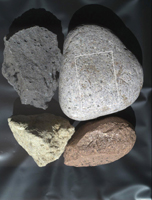
|
Test Close-Up of Earth Cobble by Mars Camera
- Click the image above for a larger view
- Full-Res JPEG (1190 x 1580) (306.6 kB)
- Full-Res TIFF (1190 x 1580) (5.6 MB)
Caption:

Fig. 1
Click on image for larger annotated version
This close-up view of a stone found in San Diego was taken by a testing twin -- the "life test unit" -- of the Mars Hand Lens Imager (MAHLI) camera for NASA's Mars Science Laboratory. The image covers a patch of rock surface about 4 centimeters (1.6 inches) wide, with the shadow of the camera falling across part of the photographed area.
As a demonstration of how MAHLI's adjustable focus may be used on Mars, this image can be compared with PIA13583 , taken from farther enough away to see this entire rock and three others. The inscribed rectangle on Fig. 1 indicates the portion of the rock covered in the close-up view.
MAHLI is mounted at the end of the robotic arm on the Mars Science Laboratory mission's Curiosity rover. By placing the camera at different distances from a target, researchers can obtain images showing broader context as well as finer detail.
This image was taken outside, under natural sunlight. The shadowing was intentional to assess the effect of sunlight and shadow on the acquisition and processing of MAHLI images. The rock is gray rhyolite. Though collected in California, it originated in a volcanic eruption in Mexico.
Cataloging Keywords:
| Name | Value | Additional Values |
|---|---|---|
| Target | Earth | Mars |
| System | ||
| Target Type | Planet | |
| Mission | Mars Science Laboratory (MSL) | |
| Instrument Host | Curiosity Rover | |
| Host Type | Rover | |
| Instrument | Mars Hand Lens Imager (MAHLI) | |
| Detector | ||
| Extra Keywords | Color, Shadow, Volcano | |
| Acquisition Date | ||
| Release Date | 2010-11-16 | |
| Date in Caption | ||
| Image Credit | NASA/JPL-Caltech/Malin Space Science Systems | |
| Source | photojournal.jpl.nasa.gov/catalog/PIA13584 | |
| Identifier | PIA13584 | |
